Optimizing Offshore Wind Energy Project Layout for Maximum Energy
VerifiedAdded on 2023/04/25
|24
|10340
|481
Report
AI Summary
This research paper focuses on optimizing the layout of offshore wind energy projects to maximize energy capture, with a specific emphasis on the impact of varying turbine hub heights. The study employs a gradient-based optimization method, incorporating a modified version of the FLORI S wake model to simulate three-dimensional wakes and integrate them with a tower structural model. The primary objective is to minimize the cost of energy (COE) through layout optimization and the strategic use of different hub heights. The results indicate that optimizing both layout and hub height, using two separate height groups, can reduce the COE by 5% to 9% compared to layouts with turbines of the same height. The methodology includes a detailed description of the wake model, annual energy production (AEP) calculations, and structural considerations, all of which are critical for the optimization process. The study validates the wake model against SOWFA simulations and analyzes the performance of the wind farm under various atmospheric conditions to determine optimal layouts.
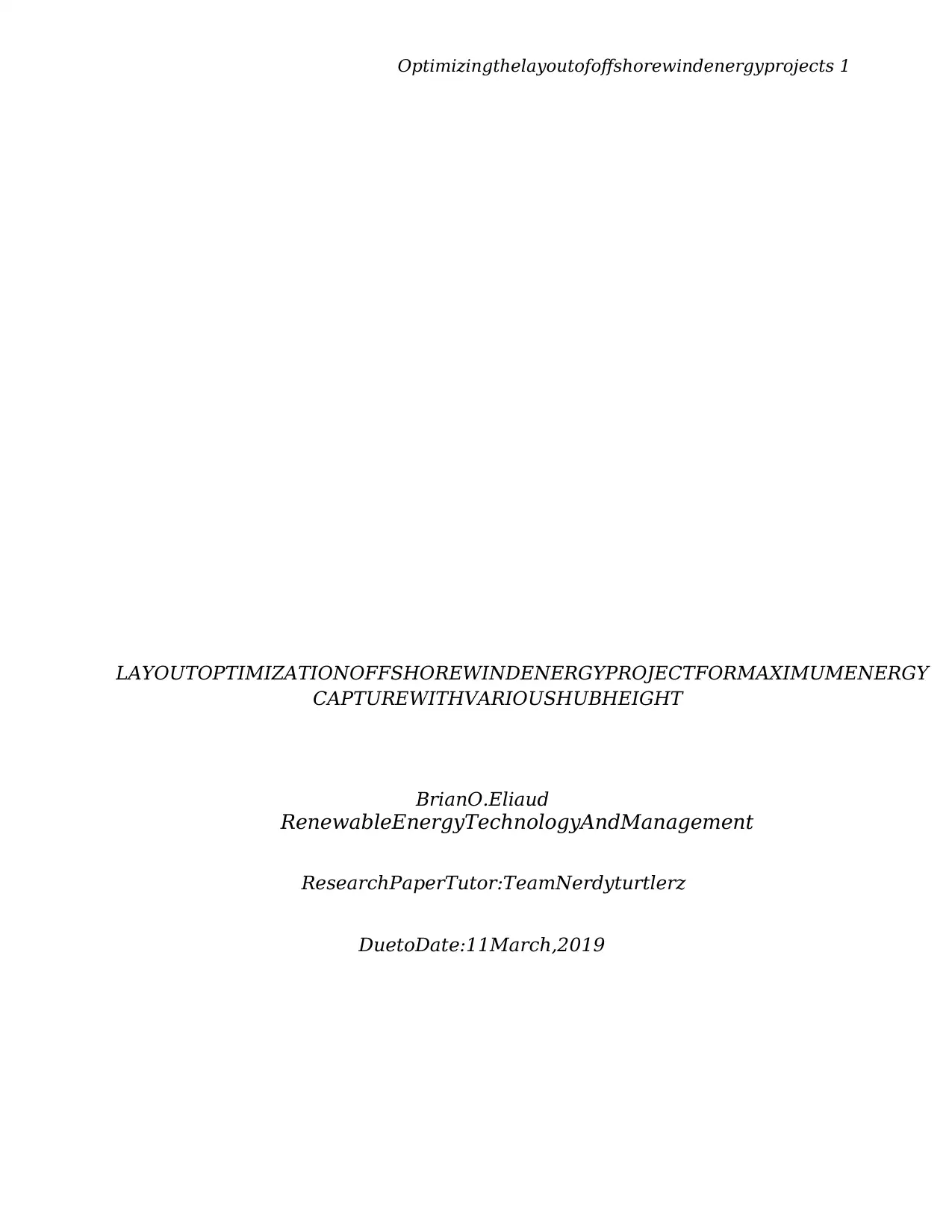
Optimizingthelayoutofoffshorewindenergyprojects 1
LAYOUTOPTIMIZATIONOFFSHOREWINDENERGYPROJECTFORMAXIMUMENERGY
CAPTUREWITHVARIOUSHUBHEIGHT
BrianO.Eliaud
RenewableEnergyTechnologyAndManagement
ResearchPaperTutor:TeamNerdyturtlerz
DuetoDate:11March,2019
LAYOUTOPTIMIZATIONOFFSHOREWINDENERGYPROJECTFORMAXIMUMENERGY
CAPTUREWITHVARIOUSHUBHEIGHT
BrianO.Eliaud
RenewableEnergyTechnologyAndManagement
ResearchPaperTutor:TeamNerdyturtlerz
DuetoDate:11March,2019
Paraphrase This Document
Need a fresh take? Get an instant paraphrase of this document with our AI Paraphraser
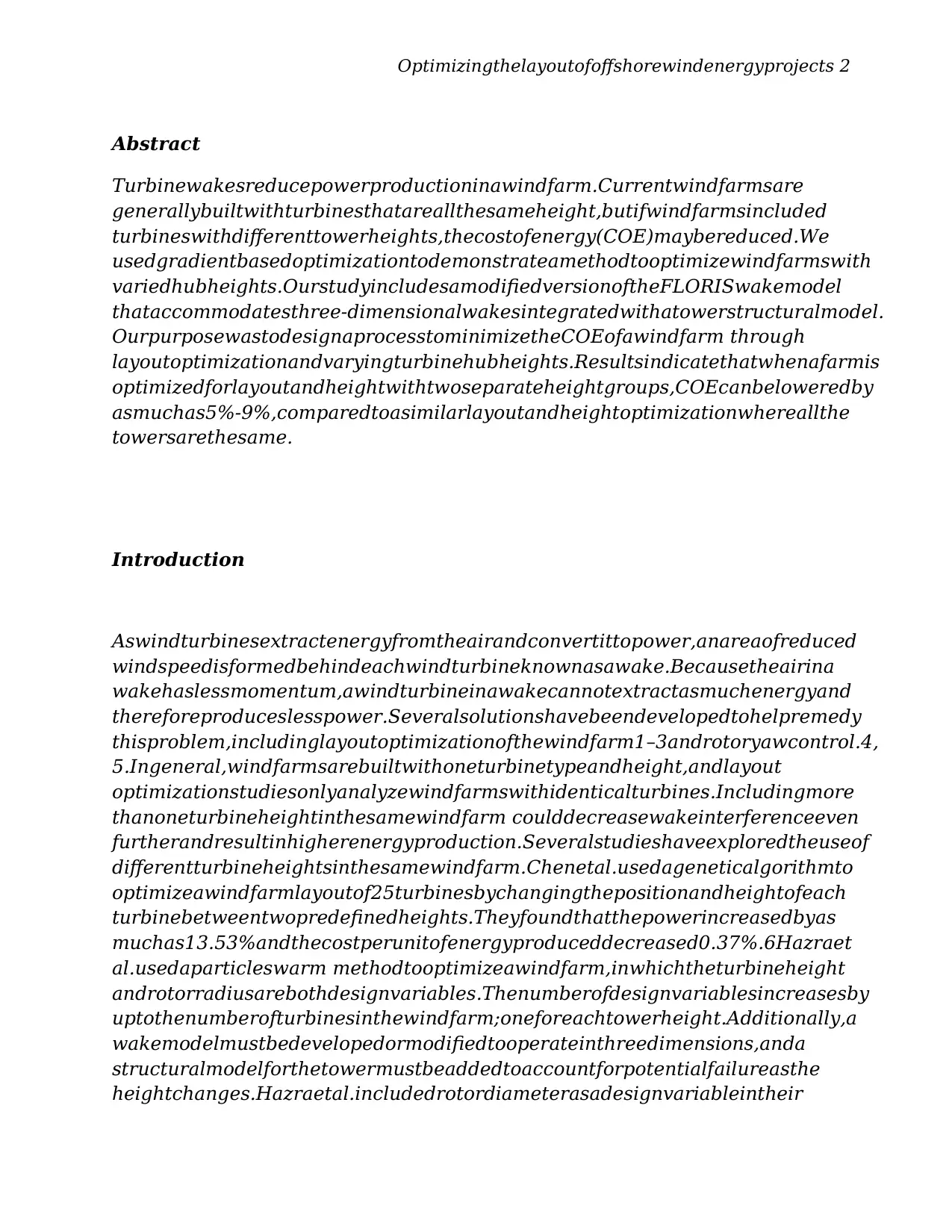
Optimizingthelayoutofoffshorewindenergyprojects 2
Abstract
Turbinewakesreducepowerproductioninawindfarm.Currentwindfarmsare
generallybuiltwithturbinesthatareallthesameheight,butifwindfarmsincluded
turbineswithdifferenttowerheights,thecostofenergy(COE)maybereduced.We
usedgradientbasedoptimizationtodemonstrateamethodtooptimizewindfarmswith
variedhubheights.OurstudyincludesamodifiedversionoftheFLORISwakemodel
thataccommodatesthree-dimensionalwakesintegratedwithatowerstructuralmodel.
OurpurposewastodesignaprocesstominimizetheCOEofawindfarm through
layoutoptimizationandvaryingturbinehubheights.Resultsindicatethatwhenafarmis
optimizedforlayoutandheightwithtwoseparateheightgroups,COEcanbeloweredby
asmuchas5%-9%,comparedtoasimilarlayoutandheightoptimizationwhereallthe
towersarethesame.
Introduction
Aswindturbinesextractenergyfromtheairandconvertittopower,anareaofreduced
windspeedisformedbehindeachwindturbineknownasawake.Becausetheairina
wakehaslessmomentum,awindturbineinawakecannotextractasmuchenergyand
thereforeproduceslesspower.Severalsolutionshavebeendevelopedtohelpremedy
thisproblem,includinglayoutoptimizationofthewindfarm1–3androtoryawcontrol.4,
5.Ingeneral,windfarmsarebuiltwithoneturbinetypeandheight,andlayout
optimizationstudiesonlyanalyzewindfarmswithidenticalturbines.Includingmore
thanoneturbineheightinthesamewindfarm coulddecreasewakeinterferenceeven
furtherandresultinhigherenergyproduction.Severalstudieshaveexploredtheuseof
differentturbineheightsinthesamewindfarm.Chenetal.usedageneticalgorithmto
optimizeawindfarmlayoutof25turbinesbychangingthepositionandheightofeach
turbinebetweentwopredefinedheights.Theyfoundthatthepowerincreasedbyas
muchas13.53%andthecostperunitofenergyproduceddecreased0.37%.6Hazraet
al.usedaparticleswarm methodtooptimizeawindfarm,inwhichtheturbineheight
androtorradiusarebothdesignvariables.Thenumberofdesignvariablesincreasesby
uptothenumberofturbinesinthewindfarm;oneforeachtowerheight.Additionally,a
wakemodelmustbedevelopedormodifiedtooperateinthreedimensions,anda
structuralmodelforthetowermustbeaddedtoaccountforpotentialfailureasthe
heightchanges.Hazraetal.includedrotordiameterasadesignvariableintheir
Abstract
Turbinewakesreducepowerproductioninawindfarm.Currentwindfarmsare
generallybuiltwithturbinesthatareallthesameheight,butifwindfarmsincluded
turbineswithdifferenttowerheights,thecostofenergy(COE)maybereduced.We
usedgradientbasedoptimizationtodemonstrateamethodtooptimizewindfarmswith
variedhubheights.OurstudyincludesamodifiedversionoftheFLORISwakemodel
thataccommodatesthree-dimensionalwakesintegratedwithatowerstructuralmodel.
OurpurposewastodesignaprocesstominimizetheCOEofawindfarm through
layoutoptimizationandvaryingturbinehubheights.Resultsindicatethatwhenafarmis
optimizedforlayoutandheightwithtwoseparateheightgroups,COEcanbeloweredby
asmuchas5%-9%,comparedtoasimilarlayoutandheightoptimizationwhereallthe
towersarethesame.
Introduction
Aswindturbinesextractenergyfromtheairandconvertittopower,anareaofreduced
windspeedisformedbehindeachwindturbineknownasawake.Becausetheairina
wakehaslessmomentum,awindturbineinawakecannotextractasmuchenergyand
thereforeproduceslesspower.Severalsolutionshavebeendevelopedtohelpremedy
thisproblem,includinglayoutoptimizationofthewindfarm1–3androtoryawcontrol.4,
5.Ingeneral,windfarmsarebuiltwithoneturbinetypeandheight,andlayout
optimizationstudiesonlyanalyzewindfarmswithidenticalturbines.Includingmore
thanoneturbineheightinthesamewindfarm coulddecreasewakeinterferenceeven
furtherandresultinhigherenergyproduction.Severalstudieshaveexploredtheuseof
differentturbineheightsinthesamewindfarm.Chenetal.usedageneticalgorithmto
optimizeawindfarmlayoutof25turbinesbychangingthepositionandheightofeach
turbinebetweentwopredefinedheights.Theyfoundthatthepowerincreasedbyas
muchas13.53%andthecostperunitofenergyproduceddecreased0.37%.6Hazraet
al.usedaparticleswarm methodtooptimizeawindfarm,inwhichtheturbineheight
androtorradiusarebothdesignvariables.Thenumberofdesignvariablesincreasesby
uptothenumberofturbinesinthewindfarm;oneforeachtowerheight.Additionally,a
wakemodelmustbedevelopedormodifiedtooperateinthreedimensions,anda
structuralmodelforthetowermustbeaddedtoaccountforpotentialfailureasthe
heightchanges.Hazraetal.includedrotordiameterasadesignvariableintheir
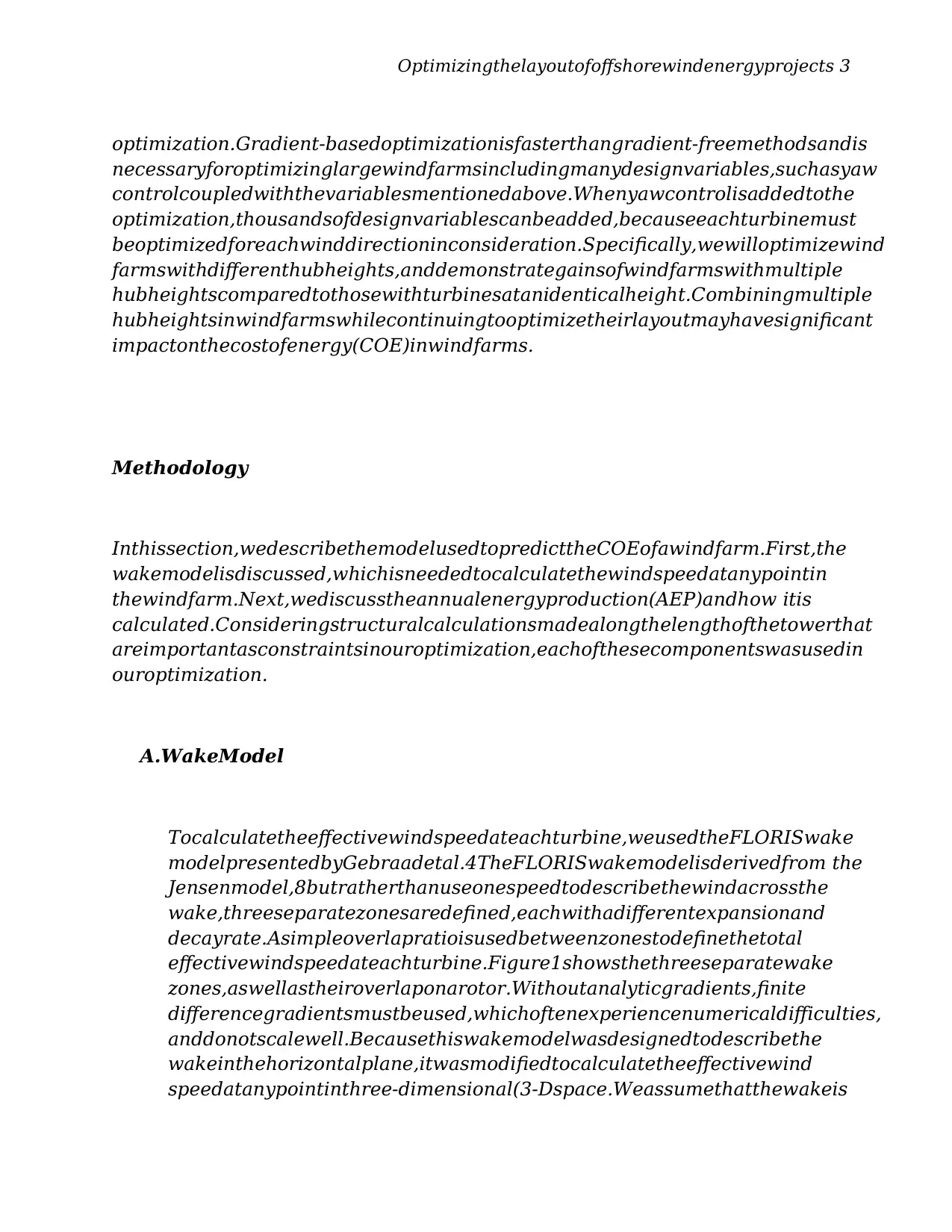
Optimizingthelayoutofoffshorewindenergyprojects 3
optimization.Gradient-basedoptimizationisfasterthangradient-freemethodsandis
necessaryforoptimizinglargewindfarmsincludingmanydesignvariables,suchasyaw
controlcoupledwiththevariablesmentionedabove.Whenyawcontrolisaddedtothe
optimization,thousandsofdesignvariablescanbeadded,becauseeachturbinemust
beoptimizedforeachwinddirectioninconsideration.Specifically,wewilloptimizewind
farmswithdifferenthubheights,anddemonstrategainsofwindfarmswithmultiple
hubheightscomparedtothosewithturbinesatanidenticalheight.Combiningmultiple
hubheightsinwindfarmswhilecontinuingtooptimizetheirlayoutmayhavesignificant
impactonthecostofenergy(COE)inwindfarms.
Methodology
Inthissection,wedescribethemodelusedtopredicttheCOEofawindfarm.First,the
wakemodelisdiscussed,whichisneededtocalculatethewindspeedatanypointin
thewindfarm.Next,wediscusstheannualenergyproduction(AEP)andhow itis
calculated.Consideringstructuralcalculationsmadealongthelengthofthetowerthat
areimportantasconstraintsinouroptimization,eachofthesecomponentswasusedin
ouroptimization.
A.WakeModel
Tocalculatetheeffectivewindspeedateachturbine,weusedtheFLORISwake
modelpresentedbyGebraadetal.4TheFLORISwakemodelisderivedfrom the
Jensenmodel,8butratherthanuseonespeedtodescribethewindacrossthe
wake,threeseparatezonesaredefined,eachwithadifferentexpansionand
decayrate.Asimpleoverlapratioisusedbetweenzonestodefinethetotal
effectivewindspeedateachturbine.Figure1showsthethreeseparatewake
zones,aswellastheiroverlaponarotor.Withoutanalyticgradients,finite
differencegradientsmustbeused,whichoftenexperiencenumericaldifficulties,
anddonotscalewell.Becausethiswakemodelwasdesignedtodescribethe
wakeinthehorizontalplane,itwasmodifiedtocalculatetheeffectivewind
speedatanypointinthree-dimensional(3-Dspace.Weassumethatthewakeis
optimization.Gradient-basedoptimizationisfasterthangradient-freemethodsandis
necessaryforoptimizinglargewindfarmsincludingmanydesignvariables,suchasyaw
controlcoupledwiththevariablesmentionedabove.Whenyawcontrolisaddedtothe
optimization,thousandsofdesignvariablescanbeadded,becauseeachturbinemust
beoptimizedforeachwinddirectioninconsideration.Specifically,wewilloptimizewind
farmswithdifferenthubheights,anddemonstrategainsofwindfarmswithmultiple
hubheightscomparedtothosewithturbinesatanidenticalheight.Combiningmultiple
hubheightsinwindfarmswhilecontinuingtooptimizetheirlayoutmayhavesignificant
impactonthecostofenergy(COE)inwindfarms.
Methodology
Inthissection,wedescribethemodelusedtopredicttheCOEofawindfarm.First,the
wakemodelisdiscussed,whichisneededtocalculatethewindspeedatanypointin
thewindfarm.Next,wediscusstheannualenergyproduction(AEP)andhow itis
calculated.Consideringstructuralcalculationsmadealongthelengthofthetowerthat
areimportantasconstraintsinouroptimization,eachofthesecomponentswasusedin
ouroptimization.
A.WakeModel
Tocalculatetheeffectivewindspeedateachturbine,weusedtheFLORISwake
modelpresentedbyGebraadetal.4TheFLORISwakemodelisderivedfrom the
Jensenmodel,8butratherthanuseonespeedtodescribethewindacrossthe
wake,threeseparatezonesaredefined,eachwithadifferentexpansionand
decayrate.Asimpleoverlapratioisusedbetweenzonestodefinethetotal
effectivewindspeedateachturbine.Figure1showsthethreeseparatewake
zones,aswellastheiroverlaponarotor.Withoutanalyticgradients,finite
differencegradientsmustbeused,whichoftenexperiencenumericaldifficulties,
anddonotscalewell.Becausethiswakemodelwasdesignedtodescribethe
wakeinthehorizontalplane,itwasmodifiedtocalculatetheeffectivewind
speedatanypointinthree-dimensional(3-Dspace.Weassumethatthewakeis
⊘ This is a preview!⊘
Do you want full access?
Subscribe today to unlock all pages.

Trusted by 1+ million students worldwide
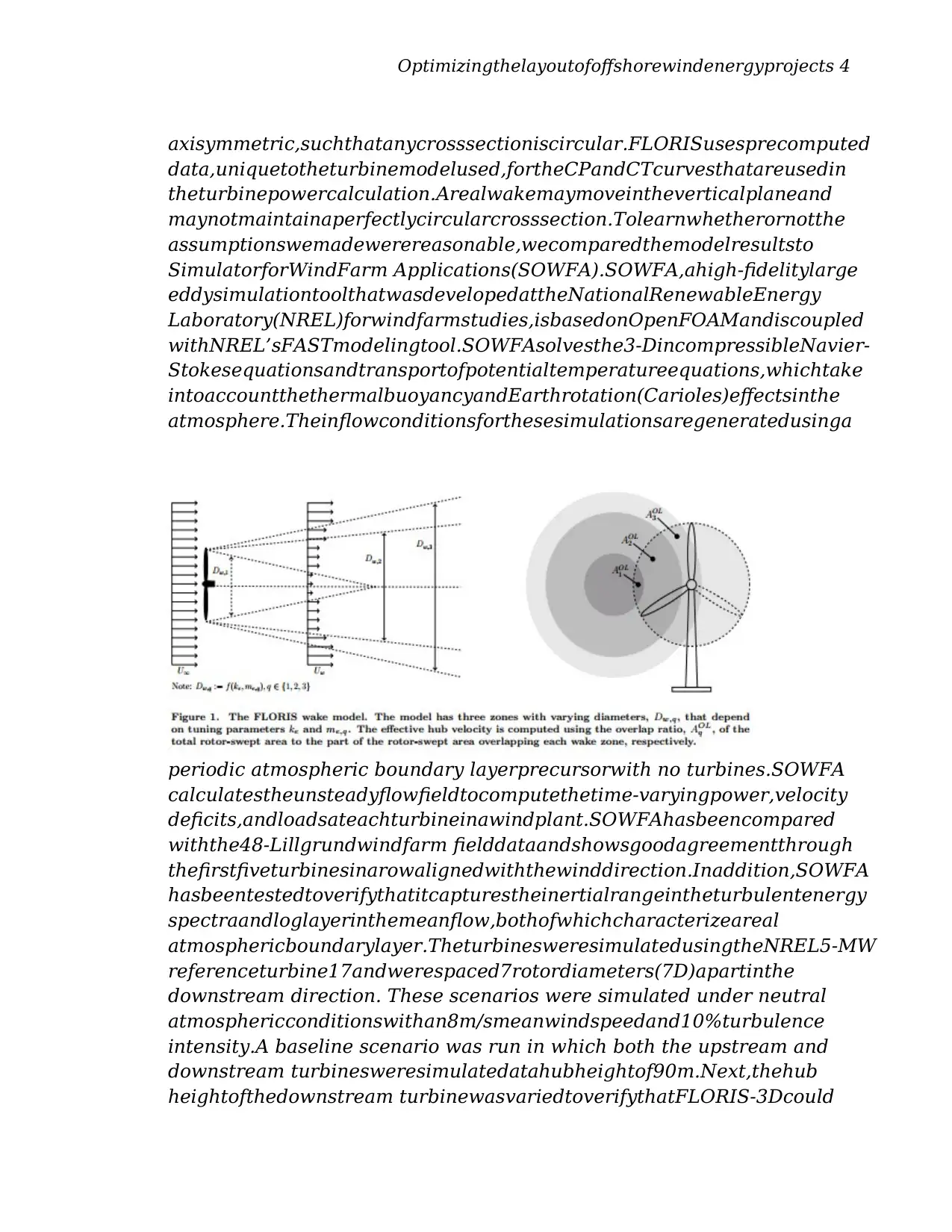
Optimizingthelayoutofoffshorewindenergyprojects 4
axisymmetric,suchthatanycrosssectioniscircular.FLORISusesprecomputed
data,uniquetotheturbinemodelused,fortheCPandCTcurvesthatareusedin
theturbinepowercalculation.Arealwakemaymoveintheverticalplaneand
maynotmaintainaperfectlycircularcrosssection.Tolearnwhetherornotthe
assumptionswemadewerereasonable,wecomparedthemodelresultsto
SimulatorforWindFarm Applications(SOWFA).SOWFA,ahigh-fidelitylarge
eddysimulationtoolthatwasdevelopedattheNationalRenewableEnergy
Laboratory(NREL)forwindfarmstudies,isbasedonOpenFOAMandiscoupled
withNREL’sFASTmodelingtool.SOWFAsolvesthe3-DincompressibleNavier-
Stokesequationsandtransportofpotentialtemperatureequations,whichtake
intoaccountthethermalbuoyancyandEarthrotation(Carioles)effectsinthe
atmosphere.Theinflowconditionsforthesesimulationsaregeneratedusinga
periodic atmospheric boundary layerprecursorwith no turbines.SOWFA
calculatestheunsteadyflowfieldtocomputethetime-varyingpower,velocity
deficits,andloadsateachturbineinawindplant.SOWFAhasbeencompared
withthe48-Lillgrundwindfarm fielddataandshowsgoodagreementthrough
thefirstfiveturbinesinarowalignedwiththewinddirection.Inaddition,SOWFA
hasbeentestedtoverifythatitcapturestheinertialrangeintheturbulentenergy
spectraandloglayerinthemeanflow,bothofwhichcharacterizeareal
atmosphericboundarylayer.TheturbinesweresimulatedusingtheNREL5-MW
referenceturbine17andwerespaced7rotordiameters(7D)apartinthe
downstream direction. These scenarios were simulated under neutral
atmosphericconditionswithan8m/smeanwindspeedand10%turbulence
intensity.A baseline scenario was run in which both the upstream and
downstream turbinesweresimulatedatahubheightof90m.Next,thehub
heightofthedownstream turbinewasvariedtoverifythatFLORIS-3Dcould
axisymmetric,suchthatanycrosssectioniscircular.FLORISusesprecomputed
data,uniquetotheturbinemodelused,fortheCPandCTcurvesthatareusedin
theturbinepowercalculation.Arealwakemaymoveintheverticalplaneand
maynotmaintainaperfectlycircularcrosssection.Tolearnwhetherornotthe
assumptionswemadewerereasonable,wecomparedthemodelresultsto
SimulatorforWindFarm Applications(SOWFA).SOWFA,ahigh-fidelitylarge
eddysimulationtoolthatwasdevelopedattheNationalRenewableEnergy
Laboratory(NREL)forwindfarmstudies,isbasedonOpenFOAMandiscoupled
withNREL’sFASTmodelingtool.SOWFAsolvesthe3-DincompressibleNavier-
Stokesequationsandtransportofpotentialtemperatureequations,whichtake
intoaccountthethermalbuoyancyandEarthrotation(Carioles)effectsinthe
atmosphere.Theinflowconditionsforthesesimulationsaregeneratedusinga
periodic atmospheric boundary layerprecursorwith no turbines.SOWFA
calculatestheunsteadyflowfieldtocomputethetime-varyingpower,velocity
deficits,andloadsateachturbineinawindplant.SOWFAhasbeencompared
withthe48-Lillgrundwindfarm fielddataandshowsgoodagreementthrough
thefirstfiveturbinesinarowalignedwiththewinddirection.Inaddition,SOWFA
hasbeentestedtoverifythatitcapturestheinertialrangeintheturbulentenergy
spectraandloglayerinthemeanflow,bothofwhichcharacterizeareal
atmosphericboundarylayer.TheturbinesweresimulatedusingtheNREL5-MW
referenceturbine17andwerespaced7rotordiameters(7D)apartinthe
downstream direction. These scenarios were simulated under neutral
atmosphericconditionswithan8m/smeanwindspeedand10%turbulence
intensity.A baseline scenario was run in which both the upstream and
downstream turbinesweresimulatedatahubheightof90m.Next,thehub
heightofthedownstream turbinewasvariedtoverifythatFLORIS-3Dcould
Paraphrase This Document
Need a fresh take? Get an instant paraphrase of this document with our AI Paraphraser
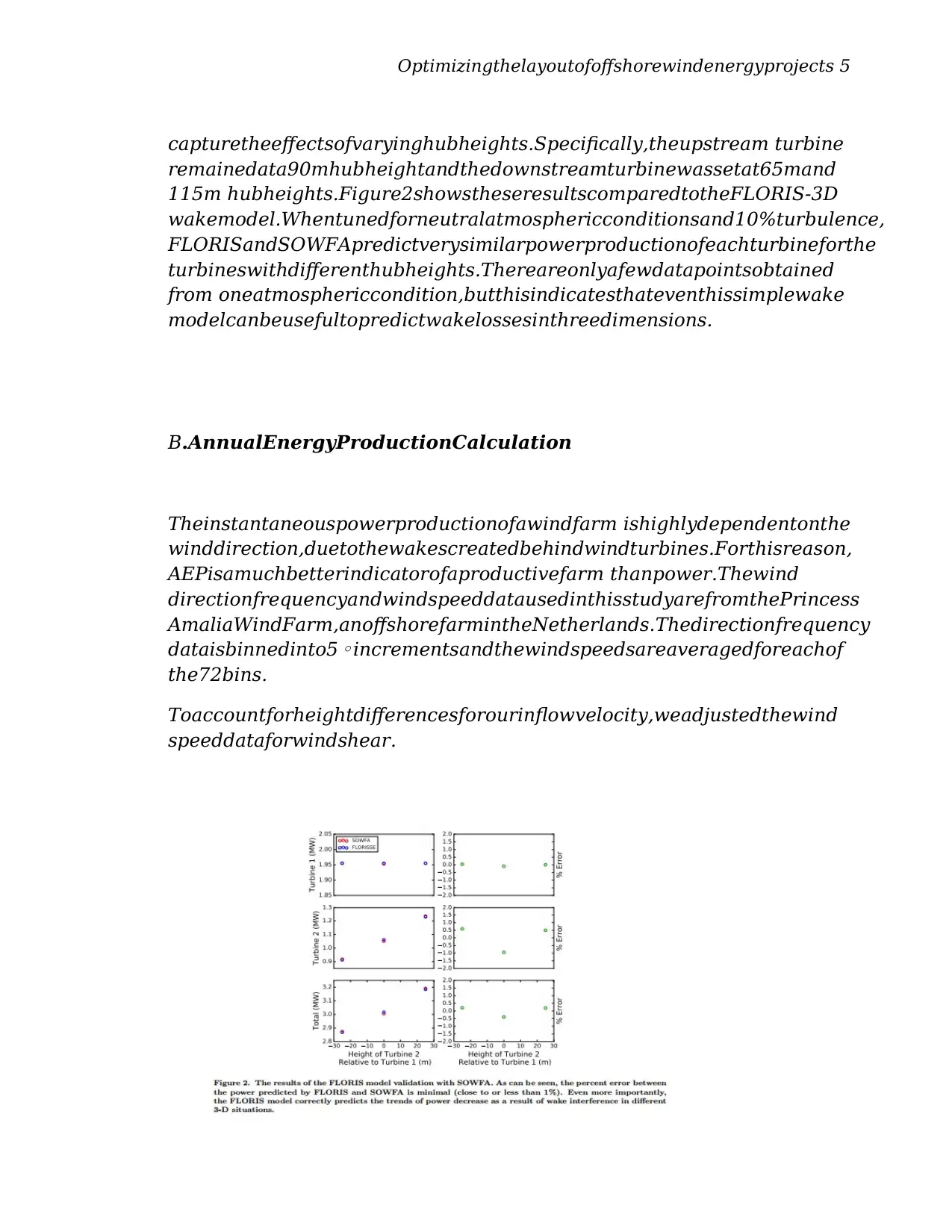
Optimizingthelayoutofoffshorewindenergyprojects 5
capturetheeffectsofvaryinghubheights.Specifically,theupstream turbine
remainedata90mhubheightandthedownstreamturbinewassetat65mand
115m hubheights.Figure2showstheseresultscomparedtotheFLORIS-3D
wakemodel.Whentunedforneutralatmosphericconditionsand10%turbulence,
FLORISandSOWFApredictverysimilarpowerproductionofeachturbineforthe
turbineswithdifferenthubheights.Thereareonlyafewdatapointsobtained
from oneatmosphericcondition,butthisindicatesthateventhissimplewake
modelcanbeusefultopredictwakelossesinthreedimensions.
B.AnnualEnergyProductionCalculation
Theinstantaneouspowerproductionofawindfarm ishighlydependentonthe
winddirection,duetothewakescreatedbehindwindturbines.Forthisreason,
AEPisamuchbetterindicatorofaproductivefarm thanpower.Thewind
directionfrequencyandwindspeeddatausedinthisstudyarefromthePrincess
AmaliaWindFarm,anoffshorefarmintheNetherlands.Thedirectionfrequency
dataisbinnedinto5
◦incrementsandthewindspeedsareaveragedforeachof
the72bins.
Toaccountforheightdifferencesforourinflowvelocity,weadjustedthewind
speeddataforwindshear.
capturetheeffectsofvaryinghubheights.Specifically,theupstream turbine
remainedata90mhubheightandthedownstreamturbinewassetat65mand
115m hubheights.Figure2showstheseresultscomparedtotheFLORIS-3D
wakemodel.Whentunedforneutralatmosphericconditionsand10%turbulence,
FLORISandSOWFApredictverysimilarpowerproductionofeachturbineforthe
turbineswithdifferenthubheights.Thereareonlyafewdatapointsobtained
from oneatmosphericcondition,butthisindicatesthateventhissimplewake
modelcanbeusefultopredictwakelossesinthreedimensions.
B.AnnualEnergyProductionCalculation
Theinstantaneouspowerproductionofawindfarm ishighlydependentonthe
winddirection,duetothewakescreatedbehindwindturbines.Forthisreason,
AEPisamuchbetterindicatorofaproductivefarm thanpower.Thewind
directionfrequencyandwindspeeddatausedinthisstudyarefromthePrincess
AmaliaWindFarm,anoffshorefarmintheNetherlands.Thedirectionfrequency
dataisbinnedinto5
◦incrementsandthewindspeedsareaveragedforeachof
the72bins.
Toaccountforheightdifferencesforourinflowvelocity,weadjustedthewind
speeddataforwindshear.
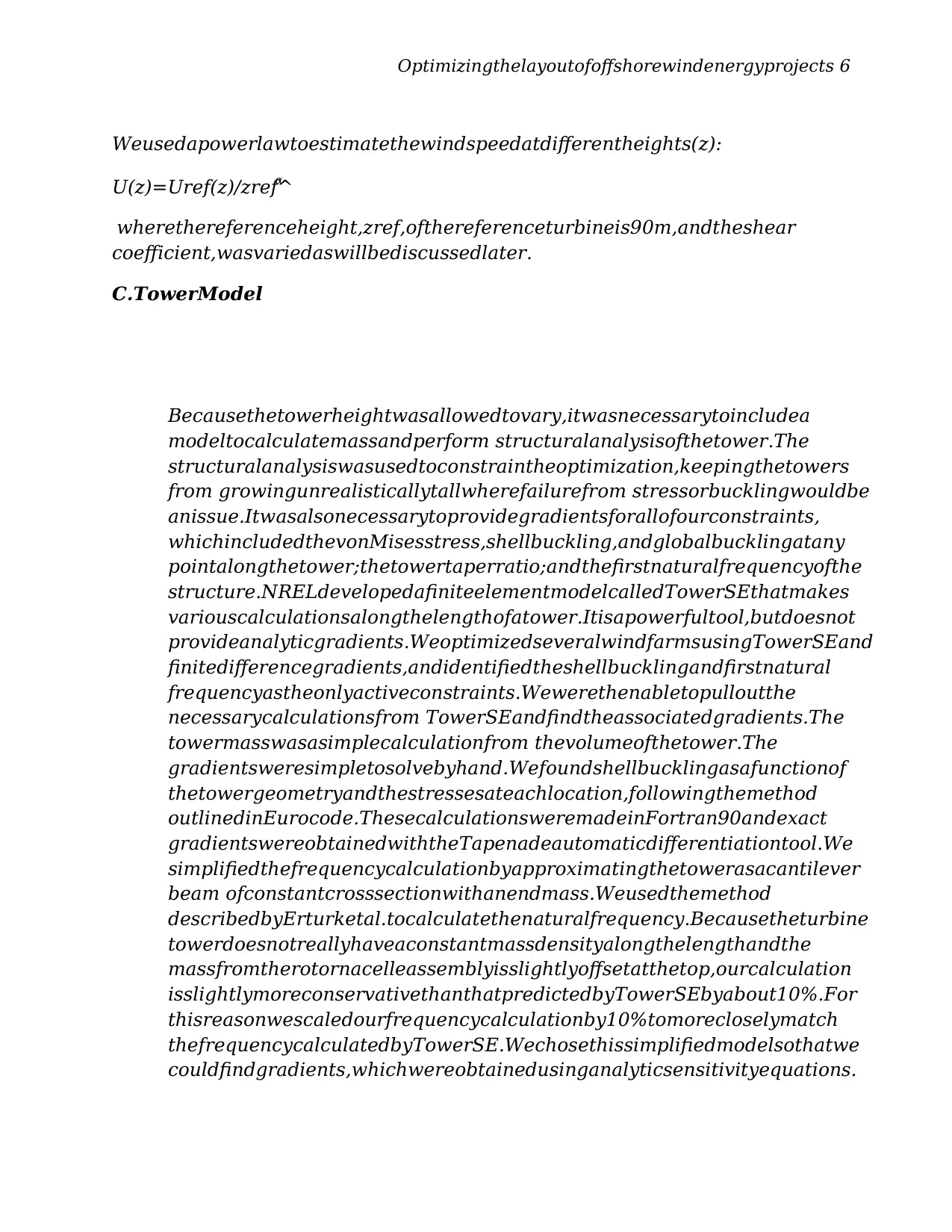
Optimizingthelayoutofoffshorewindenergyprojects 6
Weusedapowerlawtoestimatethewindspeedatdifferentheights(z):
U(z)=Uref(z)/zref^
α
wherethereferenceheight,zref,ofthereferenceturbineis90m,andtheshear
coefficient,wasvariedaswillbediscussedlater.
C.TowerModel
Becausethetowerheightwasallowedtovary,itwasnecessarytoincludea
modeltocalculatemassandperform structuralanalysisofthetower.The
structuralanalysiswasusedtoconstraintheoptimization,keepingthetowers
from growingunrealisticallytallwherefailurefrom stressorbucklingwouldbe
anissue.Itwasalsonecessarytoprovidegradientsforallofourconstraints,
whichincludedthevonMisesstress,shellbuckling,andglobalbucklingatany
pointalongthetower;thetowertaperratio;andthefirstnaturalfrequencyofthe
structure.NRELdevelopedafiniteelementmodelcalledTowerSEthatmakes
variouscalculationsalongthelengthofatower.Itisapowerfultool,butdoesnot
provideanalyticgradients.WeoptimizedseveralwindfarmsusingTowerSEand
finitedifferencegradients,andidentifiedtheshellbucklingandfirstnatural
frequencyastheonlyactiveconstraints.Wewerethenabletopulloutthe
necessarycalculationsfrom TowerSEandfindtheassociatedgradients.The
towermasswasasimplecalculationfrom thevolumeofthetower.The
gradientsweresimpletosolvebyhand.Wefoundshellbucklingasafunctionof
thetowergeometryandthestressesateachlocation,followingthemethod
outlinedinEurocode.ThesecalculationsweremadeinFortran90andexact
gradientswereobtainedwiththeTapenadeautomaticdifferentiationtool.We
simplifiedthefrequencycalculationbyapproximatingthetowerasacantilever
beam ofconstantcrosssectionwithanendmass.Weusedthemethod
describedbyErturketal.tocalculatethenaturalfrequency.Becausetheturbine
towerdoesnotreallyhaveaconstantmassdensityalongthelengthandthe
massfromtherotornacelleassemblyisslightlyoffsetatthetop,ourcalculation
isslightlymoreconservativethanthatpredictedbyTowerSEbyabout10%.For
thisreasonwescaledourfrequencycalculationby10%tomorecloselymatch
thefrequencycalculatedbyTowerSE.Wechosethissimplifiedmodelsothatwe
couldfindgradients,whichwereobtainedusinganalyticsensitivityequations.
Weusedapowerlawtoestimatethewindspeedatdifferentheights(z):
U(z)=Uref(z)/zref^
α
wherethereferenceheight,zref,ofthereferenceturbineis90m,andtheshear
coefficient,wasvariedaswillbediscussedlater.
C.TowerModel
Becausethetowerheightwasallowedtovary,itwasnecessarytoincludea
modeltocalculatemassandperform structuralanalysisofthetower.The
structuralanalysiswasusedtoconstraintheoptimization,keepingthetowers
from growingunrealisticallytallwherefailurefrom stressorbucklingwouldbe
anissue.Itwasalsonecessarytoprovidegradientsforallofourconstraints,
whichincludedthevonMisesstress,shellbuckling,andglobalbucklingatany
pointalongthetower;thetowertaperratio;andthefirstnaturalfrequencyofthe
structure.NRELdevelopedafiniteelementmodelcalledTowerSEthatmakes
variouscalculationsalongthelengthofatower.Itisapowerfultool,butdoesnot
provideanalyticgradients.WeoptimizedseveralwindfarmsusingTowerSEand
finitedifferencegradients,andidentifiedtheshellbucklingandfirstnatural
frequencyastheonlyactiveconstraints.Wewerethenabletopulloutthe
necessarycalculationsfrom TowerSEandfindtheassociatedgradients.The
towermasswasasimplecalculationfrom thevolumeofthetower.The
gradientsweresimpletosolvebyhand.Wefoundshellbucklingasafunctionof
thetowergeometryandthestressesateachlocation,followingthemethod
outlinedinEurocode.ThesecalculationsweremadeinFortran90andexact
gradientswereobtainedwiththeTapenadeautomaticdifferentiationtool.We
simplifiedthefrequencycalculationbyapproximatingthetowerasacantilever
beam ofconstantcrosssectionwithanendmass.Weusedthemethod
describedbyErturketal.tocalculatethenaturalfrequency.Becausetheturbine
towerdoesnotreallyhaveaconstantmassdensityalongthelengthandthe
massfromtherotornacelleassemblyisslightlyoffsetatthetop,ourcalculation
isslightlymoreconservativethanthatpredictedbyTowerSEbyabout10%.For
thisreasonwescaledourfrequencycalculationby10%tomorecloselymatch
thefrequencycalculatedbyTowerSE.Wechosethissimplifiedmodelsothatwe
couldfindgradients,whichwereobtainedusinganalyticsensitivityequations.
⊘ This is a preview!⊘
Do you want full access?
Subscribe today to unlock all pages.

Trusted by 1+ million students worldwide
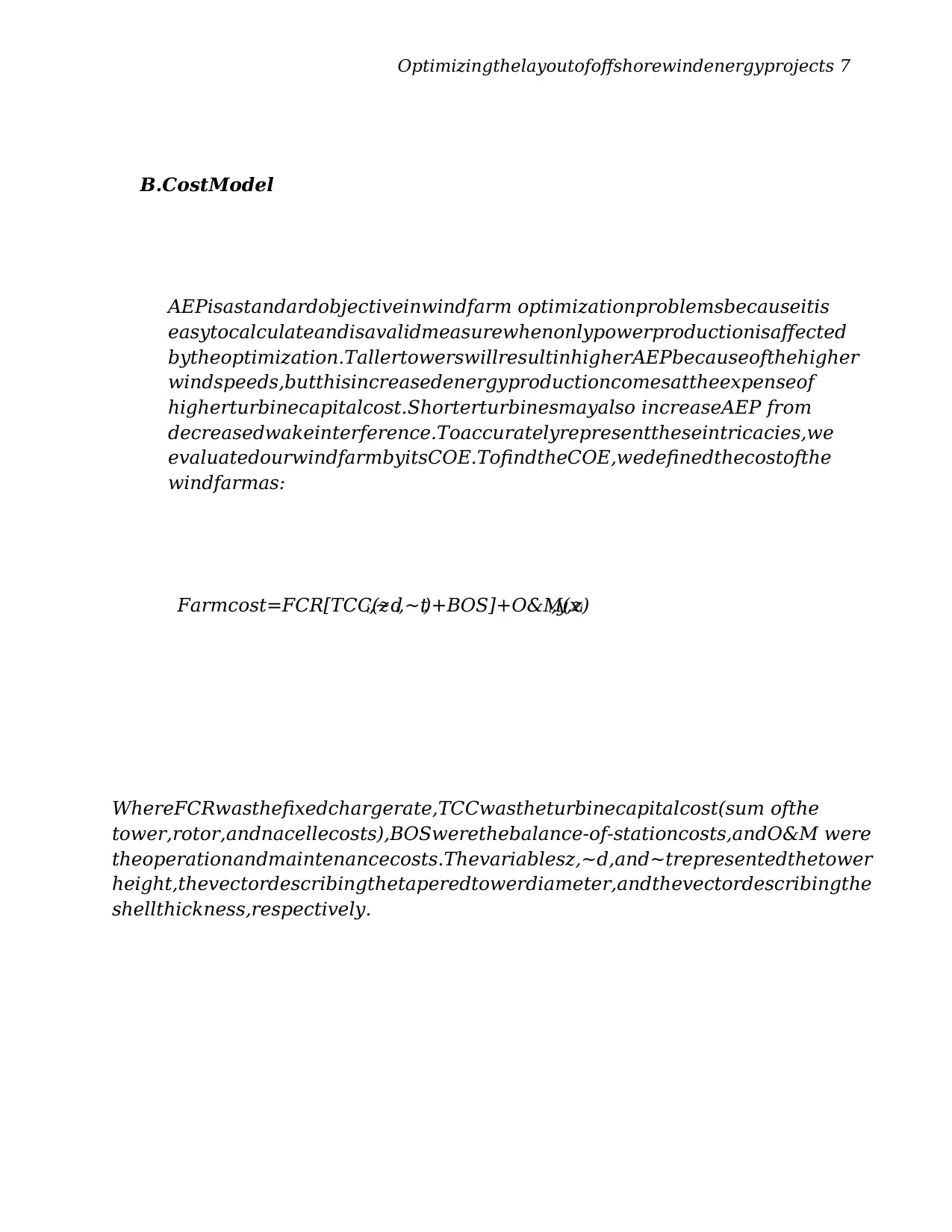
Optimizingthelayoutofoffshorewindenergyprojects 7
B.CostModel
AEPisastandardobjectiveinwindfarm optimizationproblemsbecauseitis
easytocalculateandisavalidmeasurewhenonlypowerproductionisaffected
bytheoptimization.TallertowerswillresultinhigherAEPbecauseofthehigher
windspeeds,butthisincreasedenergyproductioncomesattheexpenseof
higherturbinecapitalcost.Shorterturbinesmayalso increaseAEP from
decreasedwakeinterference.Toaccuratelyrepresenttheseintricacies,we
evaluatedourwindfarmbyitsCOE.TofindtheCOE,wedefinedthecostofthe
windfarmas:
Farmcost=FCR[TCC(zi,~di,~ti)+BOS]+O&M(xi,yi,zi)
WhereFCRwasthefixedchargerate,TCCwastheturbinecapitalcost(sum ofthe
tower,rotor,andnacellecosts),BOSwerethebalance-of-stationcosts,andO&M were
theoperationandmaintenancecosts.Thevariablesz,~d,and~trepresentedthetower
height,thevectordescribingthetaperedtowerdiameter,andthevectordescribingthe
shellthickness,respectively.
B.CostModel
AEPisastandardobjectiveinwindfarm optimizationproblemsbecauseitis
easytocalculateandisavalidmeasurewhenonlypowerproductionisaffected
bytheoptimization.TallertowerswillresultinhigherAEPbecauseofthehigher
windspeeds,butthisincreasedenergyproductioncomesattheexpenseof
higherturbinecapitalcost.Shorterturbinesmayalso increaseAEP from
decreasedwakeinterference.Toaccuratelyrepresenttheseintricacies,we
evaluatedourwindfarmbyitsCOE.TofindtheCOE,wedefinedthecostofthe
windfarmas:
Farmcost=FCR[TCC(zi,~di,~ti)+BOS]+O&M(xi,yi,zi)
WhereFCRwasthefixedchargerate,TCCwastheturbinecapitalcost(sum ofthe
tower,rotor,andnacellecosts),BOSwerethebalance-of-stationcosts,andO&M were
theoperationandmaintenancecosts.Thevariablesz,~d,and~trepresentedthetower
height,thevectordescribingthetaperedtowerdiameter,andthevectordescribingthe
shellthickness,respectively.
Paraphrase This Document
Need a fresh take? Get an instant paraphrase of this document with our AI Paraphraser
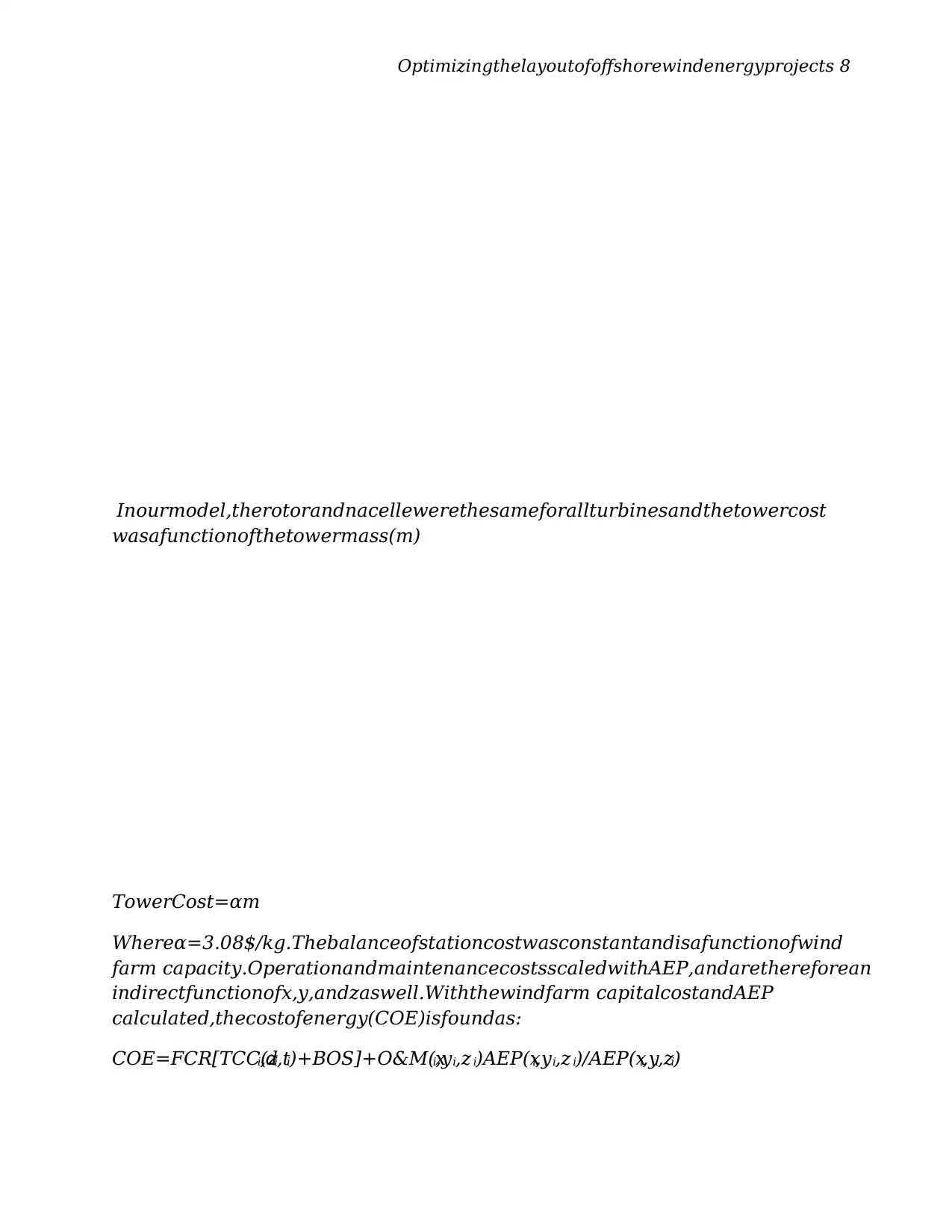
Optimizingthelayoutofoffshorewindenergyprojects 8
Inourmodel,therotorandnacellewerethesameforallturbinesandthetowercost
wasafunctionofthetowermass(m)
TowerCost=αm
Whereα=3.08$/kg.Thebalanceofstationcostwasconstantandisafunctionofwind
farm capacity.OperationandmaintenancecostsscaledwithAEP,andarethereforean
indirectfunctionofx,y,andzaswell.Withthewindfarm capitalcostandAEP
calculated,thecostofenergy(COE)isfoundas:
COE=FCR[TCC(zi,di,ti)+BOS]+O&M(xi,yi,z i)AEP(xi,yi,z i)/AEP(xi,yi,zi)
Inourmodel,therotorandnacellewerethesameforallturbinesandthetowercost
wasafunctionofthetowermass(m)
TowerCost=αm
Whereα=3.08$/kg.Thebalanceofstationcostwasconstantandisafunctionofwind
farm capacity.OperationandmaintenancecostsscaledwithAEP,andarethereforean
indirectfunctionofx,y,andzaswell.Withthewindfarm capitalcostandAEP
calculated,thecostofenergy(COE)isfoundas:
COE=FCR[TCC(zi,di,ti)+BOS]+O&M(xi,yi,z i)AEP(xi,yi,z i)/AEP(xi,yi,zi)
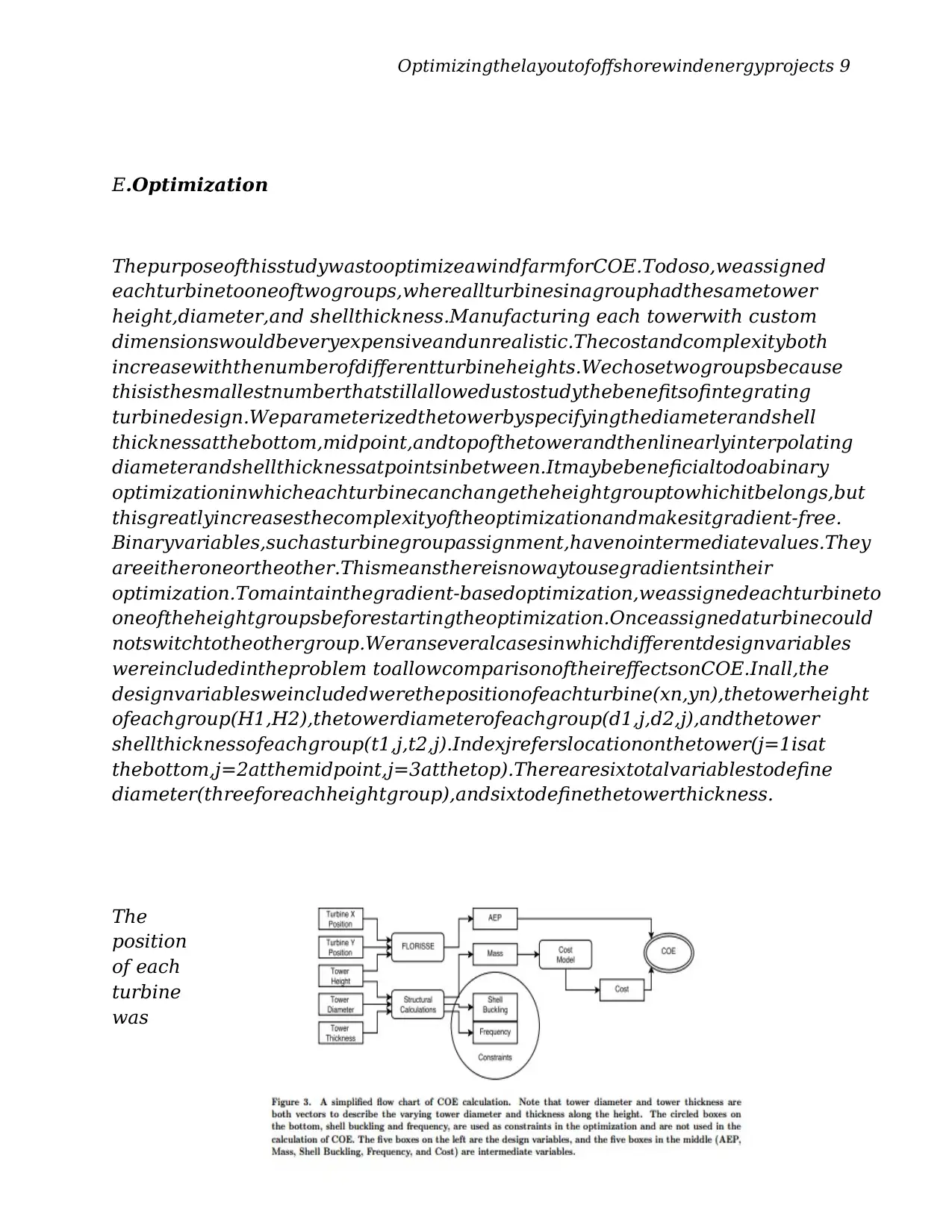
Optimizingthelayoutofoffshorewindenergyprojects 9
E.Optimization
ThepurposeofthisstudywastooptimizeawindfarmforCOE.Todoso,weassigned
eachturbinetooneoftwogroups,whereallturbinesinagrouphadthesametower
height,diameter,and shellthickness.Manufacturing each towerwith custom
dimensionswouldbeveryexpensiveandunrealistic.Thecostandcomplexityboth
increasewiththenumberofdifferentturbineheights.Wechosetwogroupsbecause
thisisthesmallestnumberthatstillallowedustostudythebenefitsofintegrating
turbinedesign.Weparameterizedthetowerbyspecifyingthediameterandshell
thicknessatthebottom,midpoint,andtopofthetowerandthenlinearlyinterpolating
diameterandshellthicknessatpointsinbetween.Itmaybebeneficialtodoabinary
optimizationinwhicheachturbinecanchangetheheightgrouptowhichitbelongs,but
thisgreatlyincreasesthecomplexityoftheoptimizationandmakesitgradient-free.
Binaryvariables,suchasturbinegroupassignment,havenointermediatevalues.They
areeitheroneortheother.Thismeansthereisnowaytousegradientsintheir
optimization.Tomaintainthegradient-basedoptimization,weassignedeachturbineto
oneoftheheightgroupsbeforestartingtheoptimization.Onceassignedaturbinecould
notswitchtotheothergroup.Weranseveralcasesinwhichdifferentdesignvariables
wereincludedintheproblem toallowcomparisonoftheireffectsonCOE.Inall,the
designvariablesweincludedwerethepositionofeachturbine(xn,yn),thetowerheight
ofeachgroup(H1,H2),thetowerdiameterofeachgroup(d1,j,d2,j),andthetower
shellthicknessofeachgroup(t1,j,t2,j).Indexjreferslocationonthetower(j=1isat
thebottom,j=2atthemidpoint,j=3atthetop).Therearesixtotalvariablestodefine
diameter(threeforeachheightgroup),andsixtodefinethetowerthickness.
The
position
of each
turbine
was
E.Optimization
ThepurposeofthisstudywastooptimizeawindfarmforCOE.Todoso,weassigned
eachturbinetooneoftwogroups,whereallturbinesinagrouphadthesametower
height,diameter,and shellthickness.Manufacturing each towerwith custom
dimensionswouldbeveryexpensiveandunrealistic.Thecostandcomplexityboth
increasewiththenumberofdifferentturbineheights.Wechosetwogroupsbecause
thisisthesmallestnumberthatstillallowedustostudythebenefitsofintegrating
turbinedesign.Weparameterizedthetowerbyspecifyingthediameterandshell
thicknessatthebottom,midpoint,andtopofthetowerandthenlinearlyinterpolating
diameterandshellthicknessatpointsinbetween.Itmaybebeneficialtodoabinary
optimizationinwhicheachturbinecanchangetheheightgrouptowhichitbelongs,but
thisgreatlyincreasesthecomplexityoftheoptimizationandmakesitgradient-free.
Binaryvariables,suchasturbinegroupassignment,havenointermediatevalues.They
areeitheroneortheother.Thismeansthereisnowaytousegradientsintheir
optimization.Tomaintainthegradient-basedoptimization,weassignedeachturbineto
oneoftheheightgroupsbeforestartingtheoptimization.Onceassignedaturbinecould
notswitchtotheothergroup.Weranseveralcasesinwhichdifferentdesignvariables
wereincludedintheproblem toallowcomparisonoftheireffectsonCOE.Inall,the
designvariablesweincludedwerethepositionofeachturbine(xn,yn),thetowerheight
ofeachgroup(H1,H2),thetowerdiameterofeachgroup(d1,j,d2,j),andthetower
shellthicknessofeachgroup(t1,j,t2,j).Indexjreferslocationonthetower(j=1isat
thebottom,j=2atthemidpoint,j=3atthetop).Therearesixtotalvariablestodefine
diameter(threeforeachheightgroup),andsixtodefinethetowerthickness.
The
position
of each
turbine
was
⊘ This is a preview!⊘
Do you want full access?
Subscribe today to unlock all pages.

Trusted by 1+ million students worldwide
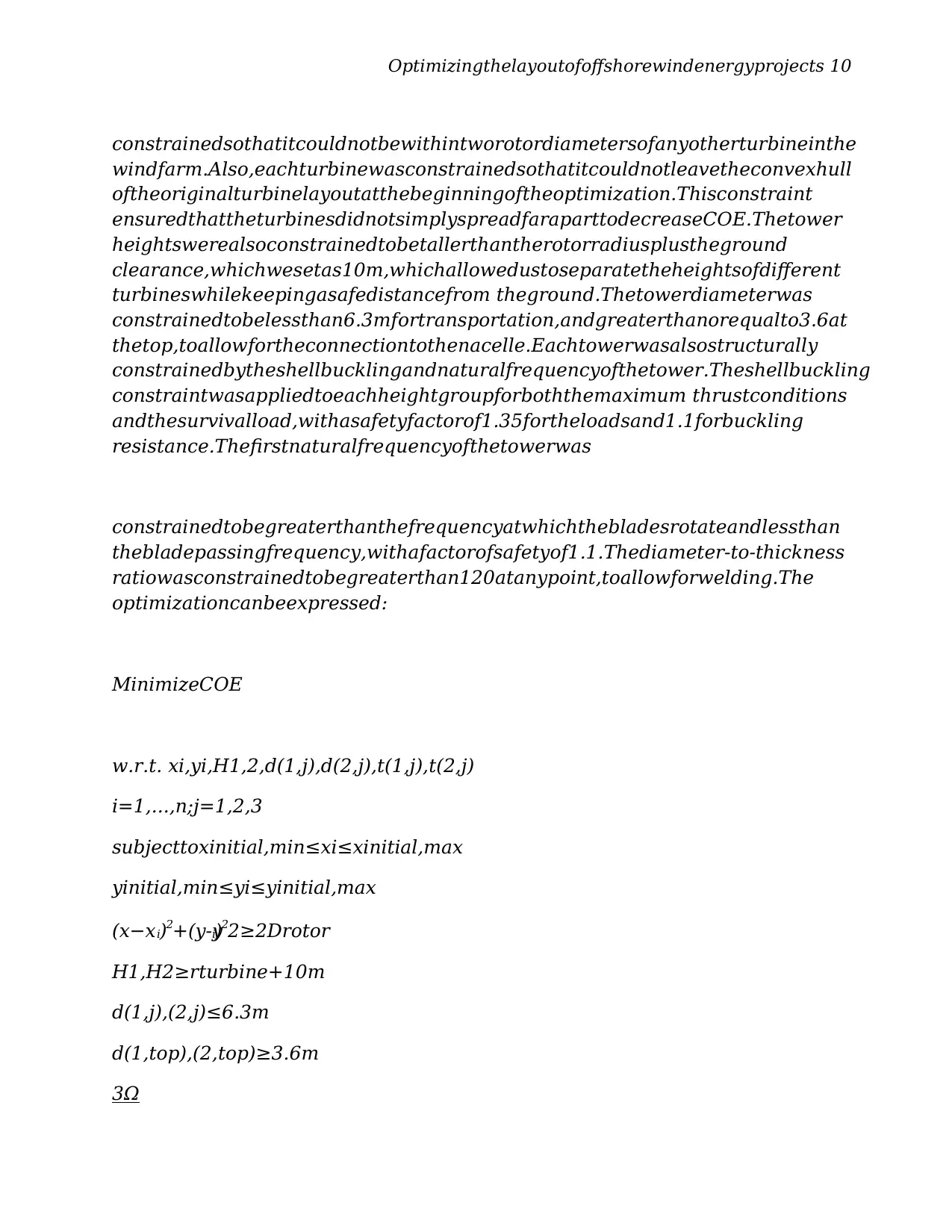
Optimizingthelayoutofoffshorewindenergyprojects 10
constrainedsothatitcouldnotbewithintworotordiametersofanyotherturbineinthe
windfarm.Also,eachturbinewasconstrainedsothatitcouldnotleavetheconvexhull
oftheoriginalturbinelayoutatthebeginningoftheoptimization.Thisconstraint
ensuredthattheturbinesdidnotsimplyspreadfaraparttodecreaseCOE.Thetower
heightswerealsoconstrainedtobetallerthantherotorradiusplustheground
clearance,whichwesetas10m,whichallowedustoseparatetheheightsofdifferent
turbineswhilekeepingasafedistancefrom theground.Thetowerdiameterwas
constrainedtobelessthan6.3mfortransportation,andgreaterthanorequalto3.6at
thetop,toallowfortheconnectiontothenacelle.Eachtowerwasalsostructurally
constrainedbytheshellbucklingandnaturalfrequencyofthetower.Theshellbuckling
constraintwasappliedtoeachheightgroupforboththemaximum thrustconditions
andthesurvivalload,withasafetyfactorof1.35fortheloadsand1.1forbuckling
resistance.Thefirstnaturalfrequencyofthetowerwas
constrainedtobegreaterthanthefrequencyatwhichthebladesrotateandlessthan
thebladepassingfrequency,withafactorofsafetyof1.1.Thediameter-to-thickness
ratiowasconstrainedtobegreaterthan120atanypoint,toallowforwelding.The
optimizationcanbeexpressed:
MinimizeCOE
w.r.t. xi,yi,H1,2,d(1,j),d(2,j),t(1,j),t(2,j)
i=1,...,n;j=1,2,3
subjecttoxinitial,min≤xi≤xinitial,max
yinitial,min≤yi≤yinitial,max
(x−xi)2+(y-yi)22≥2Drotor
H1,H2≥rturbine+10m
d(1,j),(2,j)≤6.3m
d(1,top),(2,top)≥3.6m
3Ω
constrainedsothatitcouldnotbewithintworotordiametersofanyotherturbineinthe
windfarm.Also,eachturbinewasconstrainedsothatitcouldnotleavetheconvexhull
oftheoriginalturbinelayoutatthebeginningoftheoptimization.Thisconstraint
ensuredthattheturbinesdidnotsimplyspreadfaraparttodecreaseCOE.Thetower
heightswerealsoconstrainedtobetallerthantherotorradiusplustheground
clearance,whichwesetas10m,whichallowedustoseparatetheheightsofdifferent
turbineswhilekeepingasafedistancefrom theground.Thetowerdiameterwas
constrainedtobelessthan6.3mfortransportation,andgreaterthanorequalto3.6at
thetop,toallowfortheconnectiontothenacelle.Eachtowerwasalsostructurally
constrainedbytheshellbucklingandnaturalfrequencyofthetower.Theshellbuckling
constraintwasappliedtoeachheightgroupforboththemaximum thrustconditions
andthesurvivalload,withasafetyfactorof1.35fortheloadsand1.1forbuckling
resistance.Thefirstnaturalfrequencyofthetowerwas
constrainedtobegreaterthanthefrequencyatwhichthebladesrotateandlessthan
thebladepassingfrequency,withafactorofsafetyof1.1.Thediameter-to-thickness
ratiowasconstrainedtobegreaterthan120atanypoint,toallowforwelding.The
optimizationcanbeexpressed:
MinimizeCOE
w.r.t. xi,yi,H1,2,d(1,j),d(2,j),t(1,j),t(2,j)
i=1,...,n;j=1,2,3
subjecttoxinitial,min≤xi≤xinitial,max
yinitial,min≤yi≤yinitial,max
(x−xi)2+(y-yi)22≥2Drotor
H1,H2≥rturbine+10m
d(1,j),(2,j)≤6.3m
d(1,top),(2,top)≥3.6m
3Ω
Paraphrase This Document
Need a fresh take? Get an instant paraphrase of this document with our AI Paraphraser
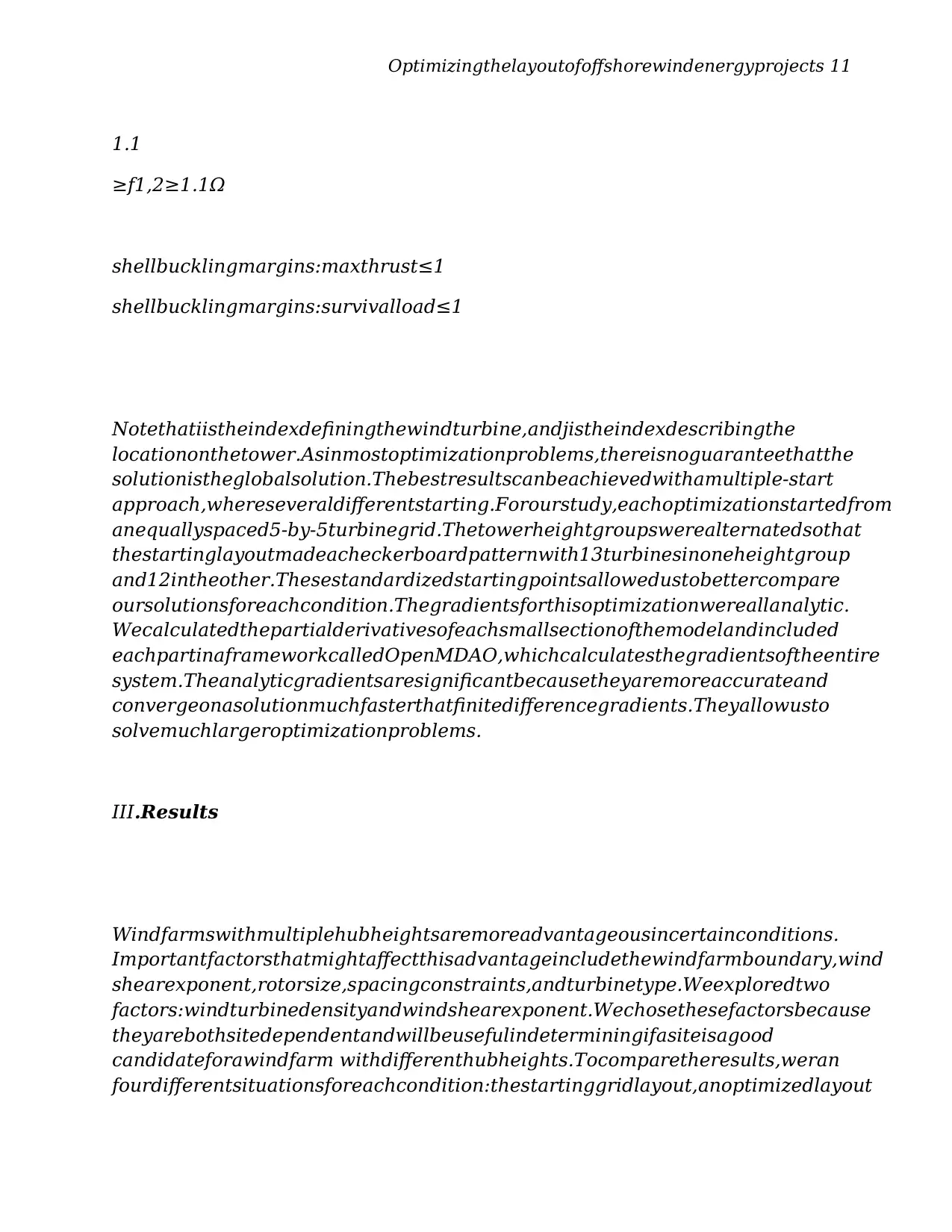
Optimizingthelayoutofoffshorewindenergyprojects 11
1.1
≥f1,2≥1.1Ω
shellbucklingmargins:maxthrust≤1
shellbucklingmargins:survivalload≤1
Notethatiistheindexdefiningthewindturbine,andjistheindexdescribingthe
locationonthetower.Asinmostoptimizationproblems,thereisnoguaranteethatthe
solutionistheglobalsolution.Thebestresultscanbeachievedwithamultiple-start
approach,whereseveraldifferentstarting.Forourstudy,eachoptimizationstartedfrom
anequallyspaced5-by-5turbinegrid.Thetowerheightgroupswerealternatedsothat
thestartinglayoutmadeacheckerboardpatternwith13turbinesinoneheightgroup
and12intheother.Thesestandardizedstartingpointsallowedustobettercompare
oursolutionsforeachcondition.Thegradientsforthisoptimizationwereallanalytic.
Wecalculatedthepartialderivativesofeachsmallsectionofthemodelandincluded
eachpartinaframeworkcalledOpenMDAO,whichcalculatesthegradientsoftheentire
system.Theanalyticgradientsaresignificantbecausetheyaremoreaccurateand
convergeonasolutionmuchfasterthatfinitedifferencegradients.Theyallowusto
solvemuchlargeroptimizationproblems.
III.Results
Windfarmswithmultiplehubheightsaremoreadvantageousincertainconditions.
Importantfactorsthatmightaffectthisadvantageincludethewindfarmboundary,wind
shearexponent,rotorsize,spacingconstraints,andturbinetype.Weexploredtwo
factors:windturbinedensityandwindshearexponent.Wechosethesefactorsbecause
theyarebothsitedependentandwillbeusefulindeterminingifasiteisagood
candidateforawindfarm withdifferenthubheights.Tocomparetheresults,weran
fourdifferentsituationsforeachcondition:thestartinggridlayout,anoptimizedlayout
1.1
≥f1,2≥1.1Ω
shellbucklingmargins:maxthrust≤1
shellbucklingmargins:survivalload≤1
Notethatiistheindexdefiningthewindturbine,andjistheindexdescribingthe
locationonthetower.Asinmostoptimizationproblems,thereisnoguaranteethatthe
solutionistheglobalsolution.Thebestresultscanbeachievedwithamultiple-start
approach,whereseveraldifferentstarting.Forourstudy,eachoptimizationstartedfrom
anequallyspaced5-by-5turbinegrid.Thetowerheightgroupswerealternatedsothat
thestartinglayoutmadeacheckerboardpatternwith13turbinesinoneheightgroup
and12intheother.Thesestandardizedstartingpointsallowedustobettercompare
oursolutionsforeachcondition.Thegradientsforthisoptimizationwereallanalytic.
Wecalculatedthepartialderivativesofeachsmallsectionofthemodelandincluded
eachpartinaframeworkcalledOpenMDAO,whichcalculatesthegradientsoftheentire
system.Theanalyticgradientsaresignificantbecausetheyaremoreaccurateand
convergeonasolutionmuchfasterthatfinitedifferencegradients.Theyallowusto
solvemuchlargeroptimizationproblems.
III.Results
Windfarmswithmultiplehubheightsaremoreadvantageousincertainconditions.
Importantfactorsthatmightaffectthisadvantageincludethewindfarmboundary,wind
shearexponent,rotorsize,spacingconstraints,andturbinetype.Weexploredtwo
factors:windturbinedensityandwindshearexponent.Wechosethesefactorsbecause
theyarebothsitedependentandwillbeusefulindeterminingifasiteisagood
candidateforawindfarm withdifferenthubheights.Tocomparetheresults,weran
fourdifferentsituationsforeachcondition:thestartinggridlayout,anoptimizedlayout
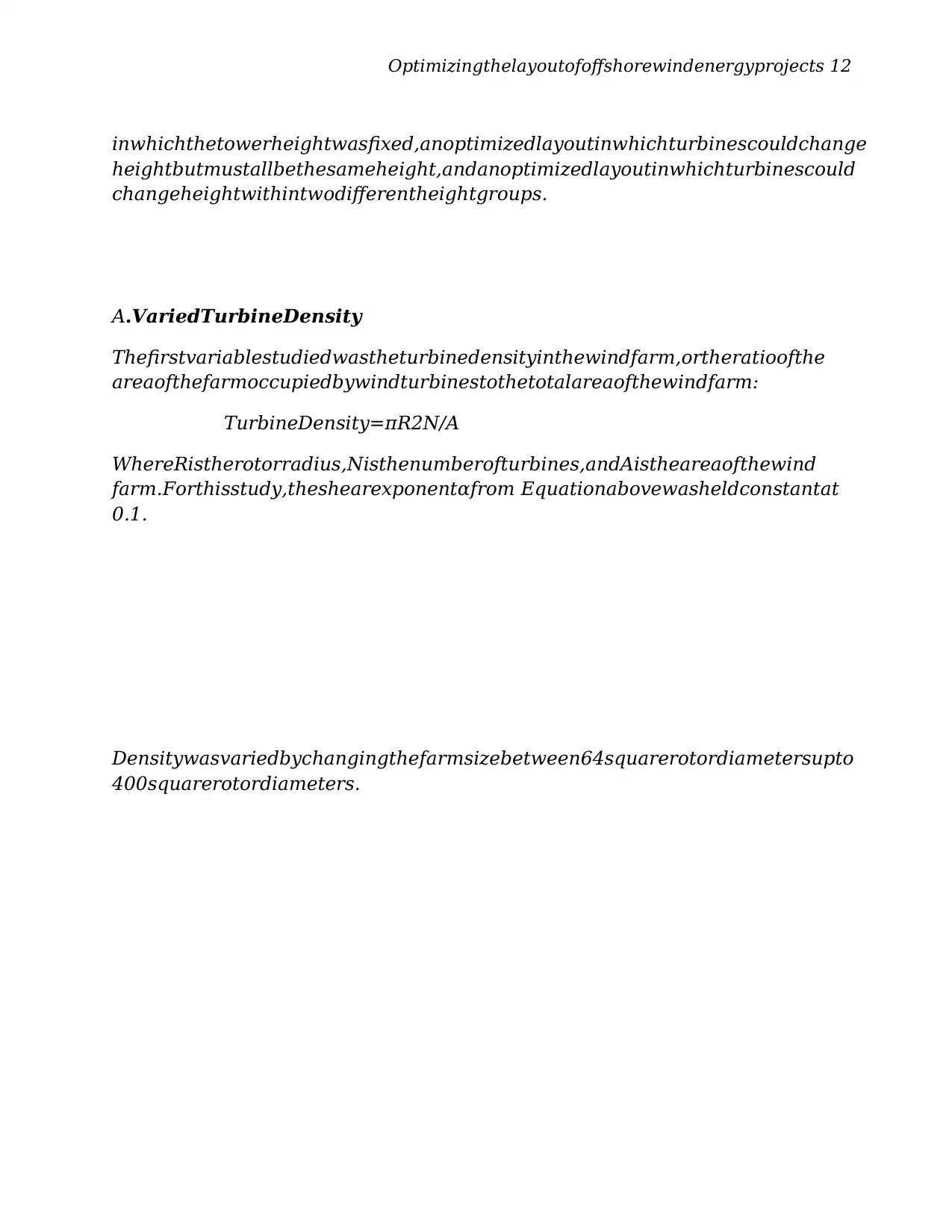
Optimizingthelayoutofoffshorewindenergyprojects 12
inwhichthetowerheightwasfixed,anoptimizedlayoutinwhichturbinescouldchange
heightbutmustallbethesameheight,andanoptimizedlayoutinwhichturbinescould
changeheightwithintwodifferentheightgroups.
A.VariedTurbineDensity
Thefirstvariablestudiedwastheturbinedensityinthewindfarm,ortheratioofthe
areaofthefarmoccupiedbywindturbinestothetotalareaofthewindfarm:
TurbineDensity=πR2N/A
WhereRistherotorradius,Nisthenumberofturbines,andAistheareaofthewind
farm.Forthisstudy,theshearexponentαfrom Equationabovewasheldconstantat
0.1.
Densitywasvariedbychangingthefarmsizebetween64squarerotordiametersupto
400squarerotordiameters.
inwhichthetowerheightwasfixed,anoptimizedlayoutinwhichturbinescouldchange
heightbutmustallbethesameheight,andanoptimizedlayoutinwhichturbinescould
changeheightwithintwodifferentheightgroups.
A.VariedTurbineDensity
Thefirstvariablestudiedwastheturbinedensityinthewindfarm,ortheratioofthe
areaofthefarmoccupiedbywindturbinestothetotalareaofthewindfarm:
TurbineDensity=πR2N/A
WhereRistherotorradius,Nisthenumberofturbines,andAistheareaofthewind
farm.Forthisstudy,theshearexponentαfrom Equationabovewasheldconstantat
0.1.
Densitywasvariedbychangingthefarmsizebetween64squarerotordiametersupto
400squarerotordiameters.
⊘ This is a preview!⊘
Do you want full access?
Subscribe today to unlock all pages.

Trusted by 1+ million students worldwide
1 out of 24
Your All-in-One AI-Powered Toolkit for Academic Success.
+13062052269
info@desklib.com
Available 24*7 on WhatsApp / Email
![[object Object]](/_next/static/media/star-bottom.7253800d.svg)
Unlock your academic potential
Copyright © 2020–2025 A2Z Services. All Rights Reserved. Developed and managed by ZUCOL.

